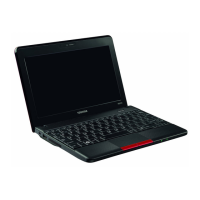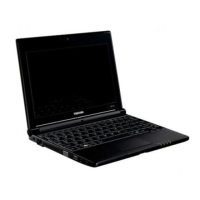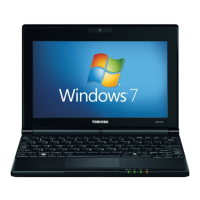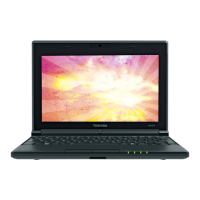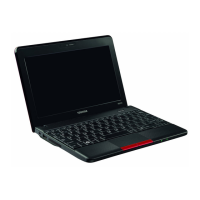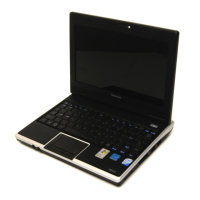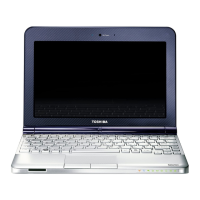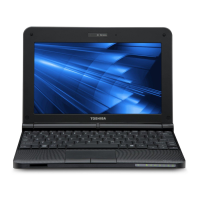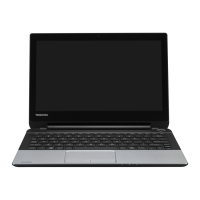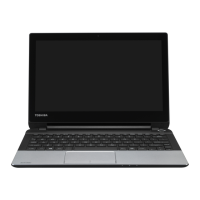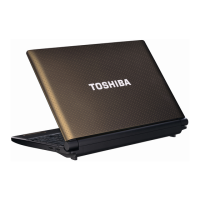
Do you have a question about the Toshiba NB520 and is the answer not in the manual?
| Storage | 320GB HDD |
|---|---|
| Graphics | Intel GMA 3650 |
| Operating System | Windows 7 Starter |
| Wireless Connectivity | Wi-Fi 802.11 b/g/n, Bluetooth 3.0 |
| Display | 10.1-inch (1024x600) |
| Battery | 6-cell battery (up to 10 hours) |
| Weight | 1.32 kg |
| Audio | Stereo speakers |
| Ports | VGA, HDMI |
| Dimensions | 262 x 190 x 16.6/35.5 mm |
| RAM | 1GB (upgradable to 2GB) |
Ensures proper airflow and prevents overheating of the computer and AC adaptor.
Tips for maintaining optimal operating conditions and protecting the workspace.
Lists items included for initial setup.
Instructions for powering the computer and charging the battery.
How to open the display panel to a suitable viewing angle.
Step-by-step instructions on powering on the computer.
Safely shutting down the computer.
Explanation of Hibernation Mode and data saving.
Methods to reset or restart the computer.
Identification of front components when the display is closed.
Identification of ports and components on the left side.
Identification of ports on the right side.
Identification of components on the back.
Identification of front components with the display open.
Description of the computer's internal hardware components.
Instructions on how to use the Touch Pad for pointer control.
Details on the keyboard layout, key types, and indicators.
Details on specific hot key functions.
Utility for creating CDs and DVDs.
Setting up a network connection.
Overview of Bluetooth technology, its features, and security.
Step-by-step instructions for connecting a LAN cable.
Description of the memory media slot and supported media types.
Instructions for inserting memory media into the slot.
Detailed steps for installing a memory module.
Detailed steps for removing a memory module.
Information on connecting an external monitor.
Information on connecting to HDMI-compatible displays.
How to use a security lock to anchor the computer.
Section covering audio control functions.
Enhancing audio experience with advanced features.
Configuring video mode settings.
Computer handling and maintenance procedures.
How the computer protects against overheating.
Describes pre-installed utilities and how to start them.
Unique or advanced features that enhance computer usability.
Changing Sleep and Charge/Music settings.
Maintaining security levels with user and supervisor passwords.
Program for configuring computer hardware settings.
Setting the priority for booting the computer.
Turning on system via key press in Sleep Mode.
Turning on computer from shutdown via LAN packet.
Tools to repair startup problems or restore the system.
Steps for creating recovery discs.
How AC adaptor and battery status affect computer operation.
How to interpret DC IN/Battery and Power indicators.
Battery types, use, recharging, and handling.
Safety precautions for battery pack use.
Procedure for recharging the battery pack.
Factors affecting battery life and tips to maximize it.
Steps to maximize battery pack life.
Detailed steps for removing the battery pack.
Detailed steps for installing the battery pack.
Describes Shut Down, Hibernation, and Sleep modes.
Automatic shutdown when idle.
Guidelines for resolving problems by stopping immediately and observing.
Questions to help identify the cause of a problem.
Steps to close unresponsive programs.
Troubleshooting issues when the computer fails to power on.
Troubleshooting AC adaptor issues.
Troubleshooting battery issues.
Issues with date and time settings.
Troubleshooting keyboard problems.
Troubleshooting display panel issues.
Troubleshooting hard disk drive issues.
Troubleshooting memory card issues.
Troubleshooting pointing device issues.
Troubleshooting USB mouse problems.
Troubleshooting USB device problems.
Troubleshooting issues with the Sleep and Charge function.
Troubleshooting sound system issues.
Troubleshooting external monitor issues.
Troubleshooting LAN connectivity.
Troubleshooting Wireless LAN access.
Troubleshooting Bluetooth device connectivity.
Contacting TOSHIBA for technical assistance.
Summarizes operating and non-operating environmental conditions.
Specifies AC adaptor and computer power requirements.
Lists certification agencies for power cords.
CPU performance variations based on operating conditions.
How main system memory is used by the graphics system.
Factors affecting battery life and its gradual decrease.
Explanation of HDD capacity reporting and variations.
LCD screen brightness deterioration over time.
GPU performance variations and Total Available Graphics Memory.
Compatibility of Wireless LAN with other systems.
Interoperability of Bluetooth cards with other products.
Compliance with radio frequency and safety standards.
Compliance with Industry Canada standards.
Compliance with FCC standards.
Japan usage notices and interference warnings.
Technical conformity certification in Japan.
Approved countries/regions for wireless chipsets.
